- Accueil
- When art comes to the station
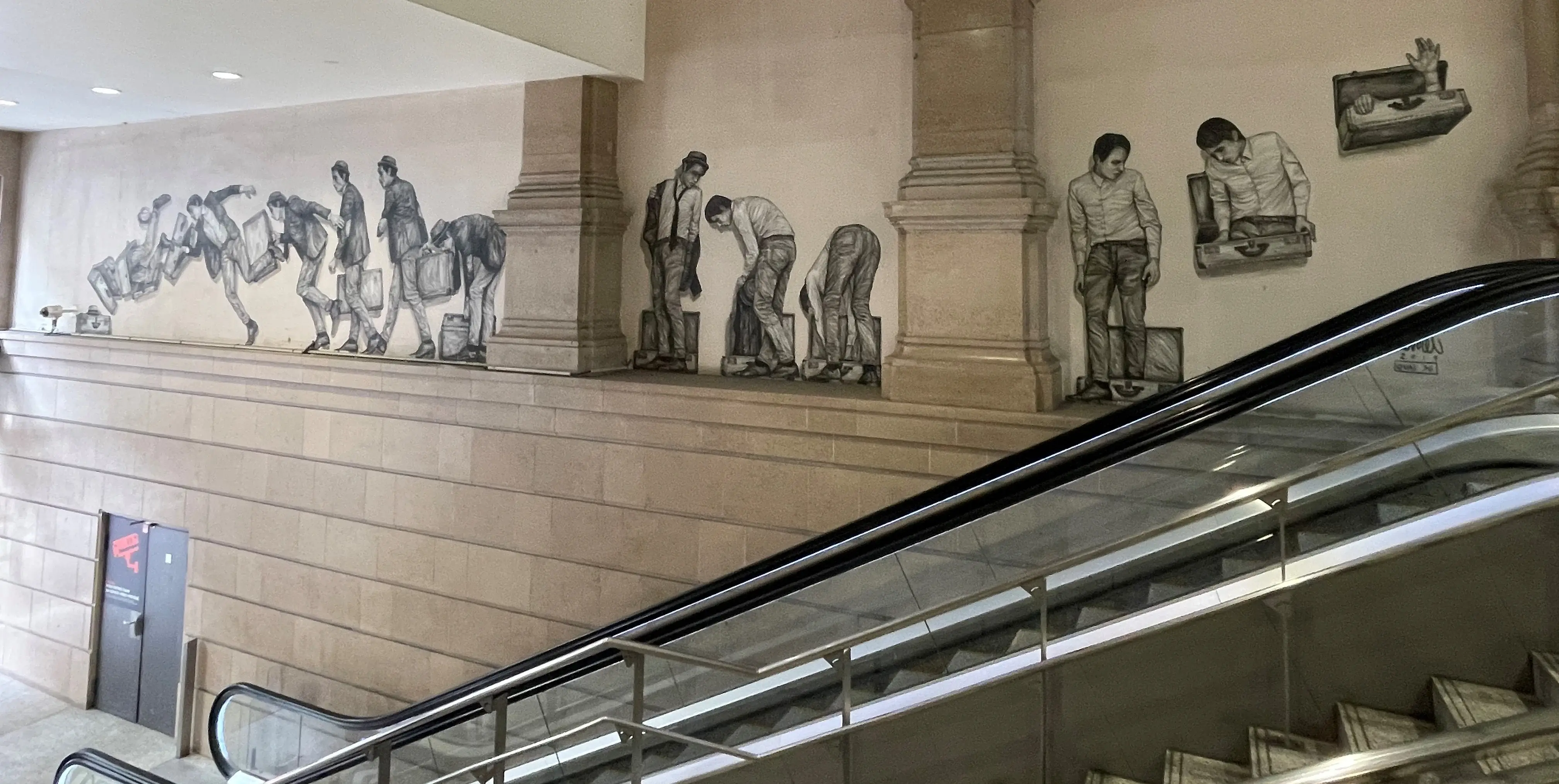
Art by the platform: Immersive art at the Gare Saint-Lazare
Art by the platform: Immersive art at the Gare Saint-Lazare
Before immersing yourself in the artistic world into which we are drawn at Saint-Lazare, don’t forget tostudy the history of a unique monument in Paris. This history presents the Gare Saint-Lazare as a living space and art gallery right in the centre of Paris. Built in 1837 during the reign of Louis-Philippe I, it was the very first railway station in Île-de-France. Also known as “the first pier in Paris”, it was therefore the departure and arrival point of the first railway built between Paris and Le Pecq in Yvelines, more precisely in Saint-Germain-en-Laye.
A building depicted over 2 centuries
The Gare Saint-Lazare in Paris, a veritable museum inside and out, has unveiled hidden artistic wealth for two centuries. This is an exceptional space where art and history collide. It offers both a permanent exhibition and also temporary exhibitions which span the ages, echoing the art galleries of Montmartre and the houses of Auguste Herbin, thus enriching the return of art to public spaces. There are many museums, exhibitions and tourist attractions accessible from the Gare Saint-Lazare.
From the industrial revolution to the present day, the station has influenced Parisian life, both through its transatlantic history and also its collection of artwork that came into being because of the building, which is listed as a site of historical heritage.
The Gare Saint-Lazare art collection invites you on a journey through time, where every nook and cranny tells a story. This station, located in the centre of Paris, is not simply a stopping-off point; it is a permanent invitation to explore the art, history and countless secrets that surround the French capital.
Artworks from 1837 to 1885
Ever since it was first constructed, this building has been a chosen subject for innumerable artists. Numerous researchers have therefore been able to analyse the various works of art and what they reveal to us. Many of them are exhibited at the Musée d’Orsay and other museums in Paris. These various studies suggest that the North facade of the original Saint-Lazare station was never really illustrated.Ever since it was first constructed, this building has been a chosen subject for innumerable artists. Numerous researchers have therefore been able to analyse the various works of art and what they reveal to us. Many of them are exhibited at the Musée d’Orsay and other museums in Paris. These various studies suggest that the North facade of the original Saint-Lazare station was never really illustrated.

“Vue du chemin de fer de Paris à St. Germain. Point de départ Place de l’Europe”, lithograph designed by J.-B. Arnout, created by Veith and Hauser
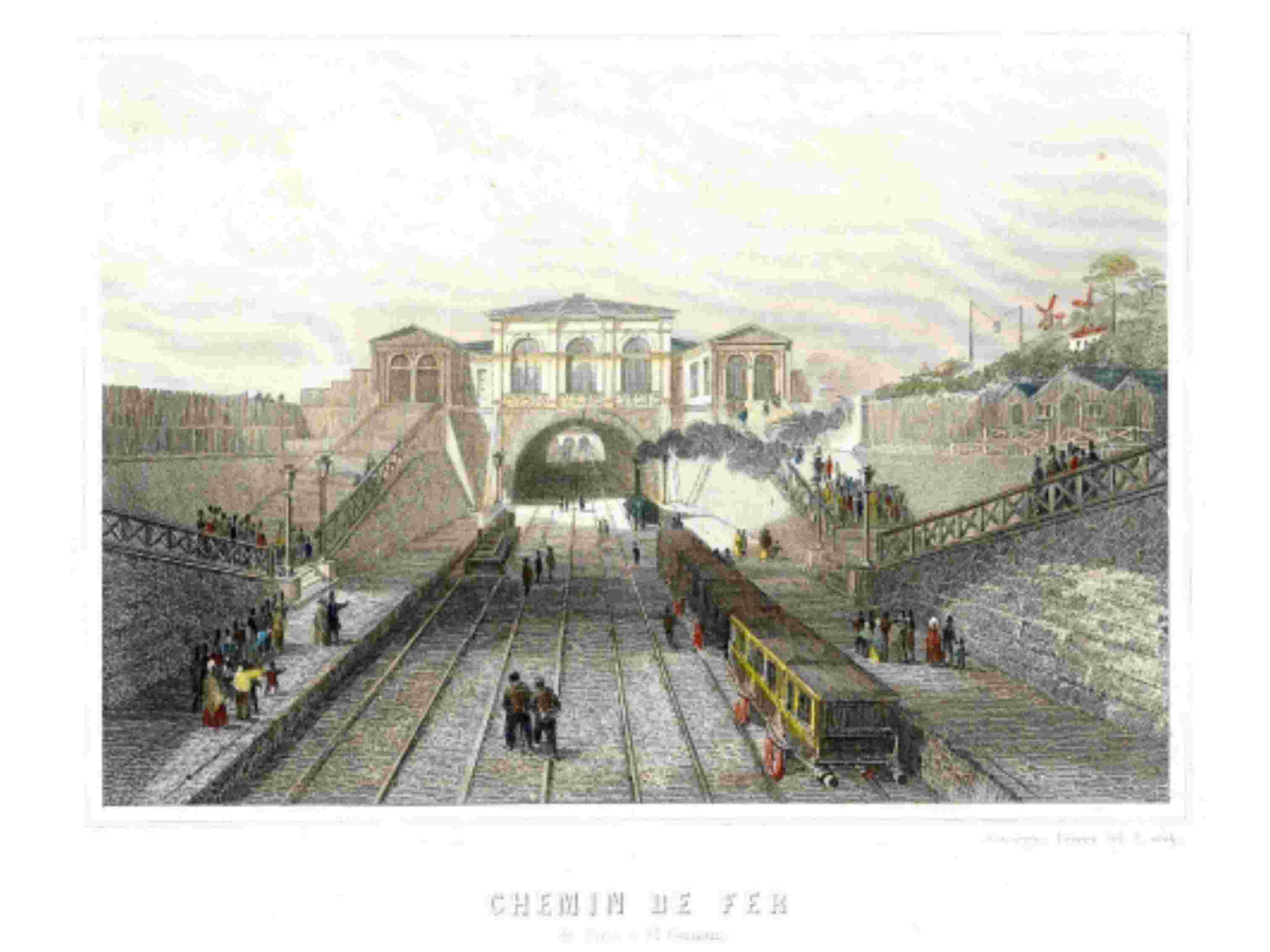
“Inauguration du chemin de fer”, by Saint-Lambert, engraving on free-standing wood
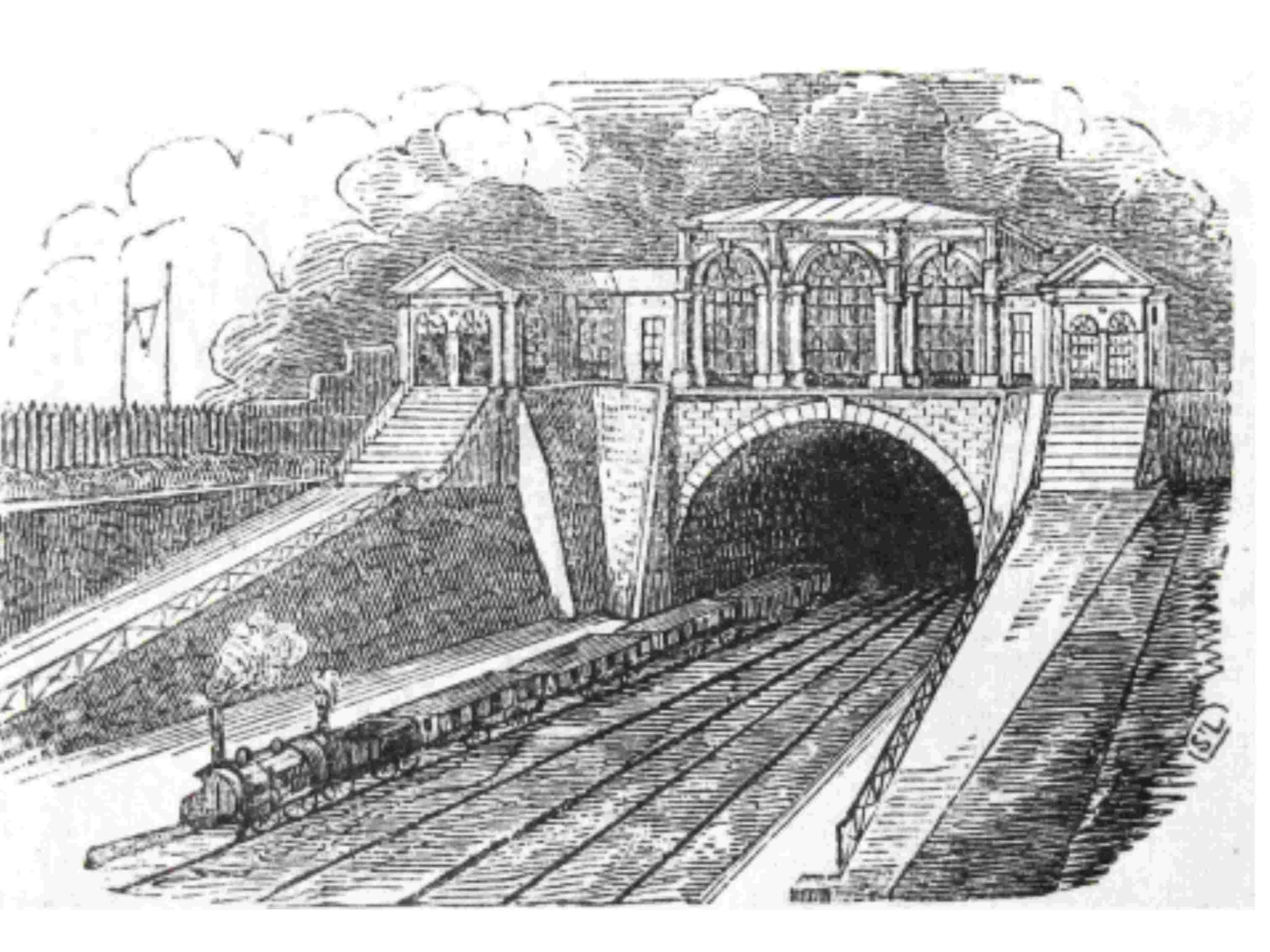
“Chemin de fer de Paris à Saint-Germain”, steel engraving by Rouargues

“Vue du télégraphe électrique à l’entrée du tunnel du débarcadère du chemin de fer de Saint-Germain”, engraving on free-standing wood, by Champin
the Gare Saint-Lazare from 1885 to the present today
In 1885, the building was extensively renovated and enlarged to respond to the changing needs of the SNCF railway network.
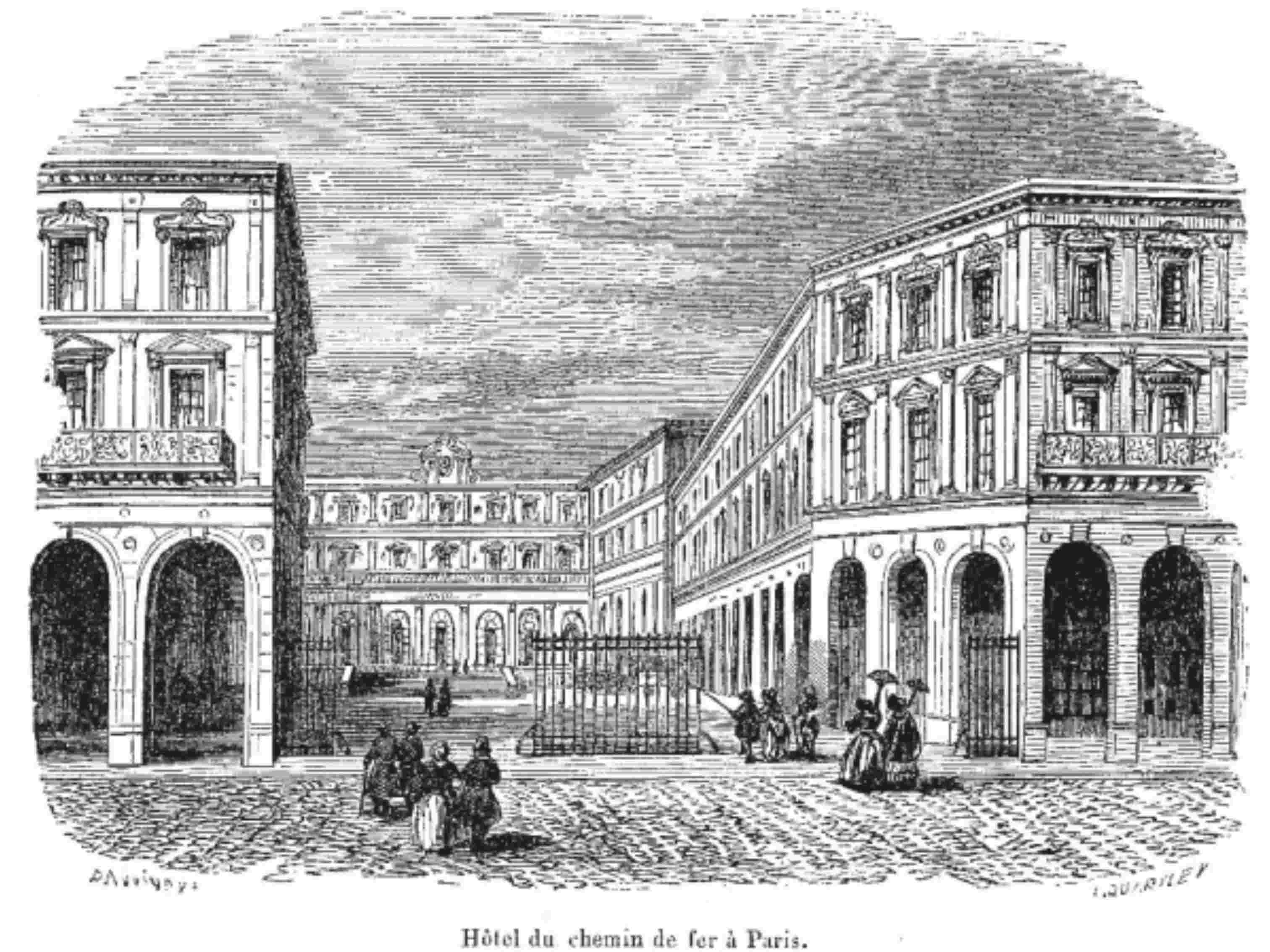
“Hôtel du chemin de fer à Paris”, engraving on free-standing wood, designed by Daubigny and engraved by Quartley
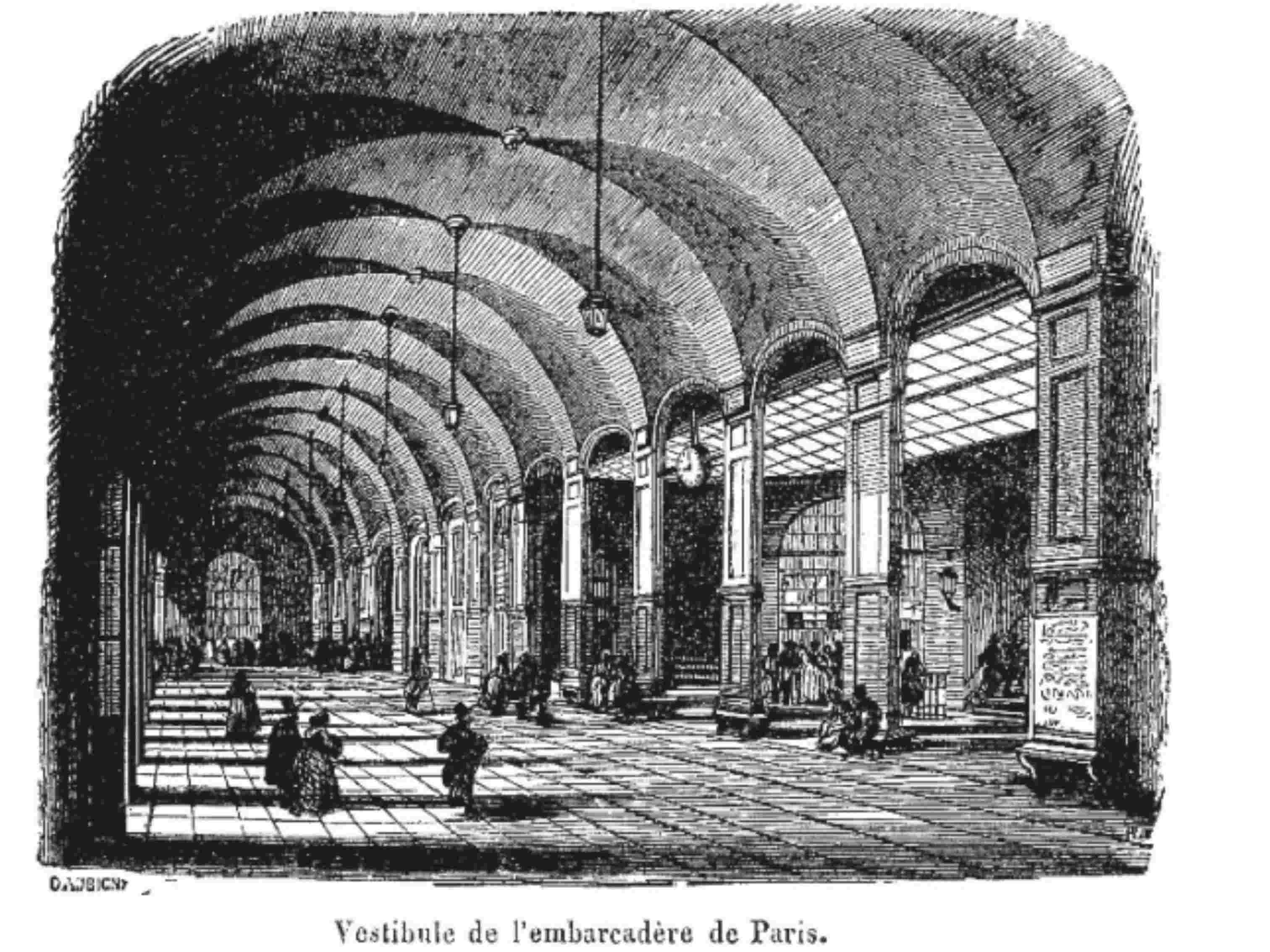
“Vestibule de l’embarcadère de Paris”, engraving on free-standing wood, designed by Daubigny
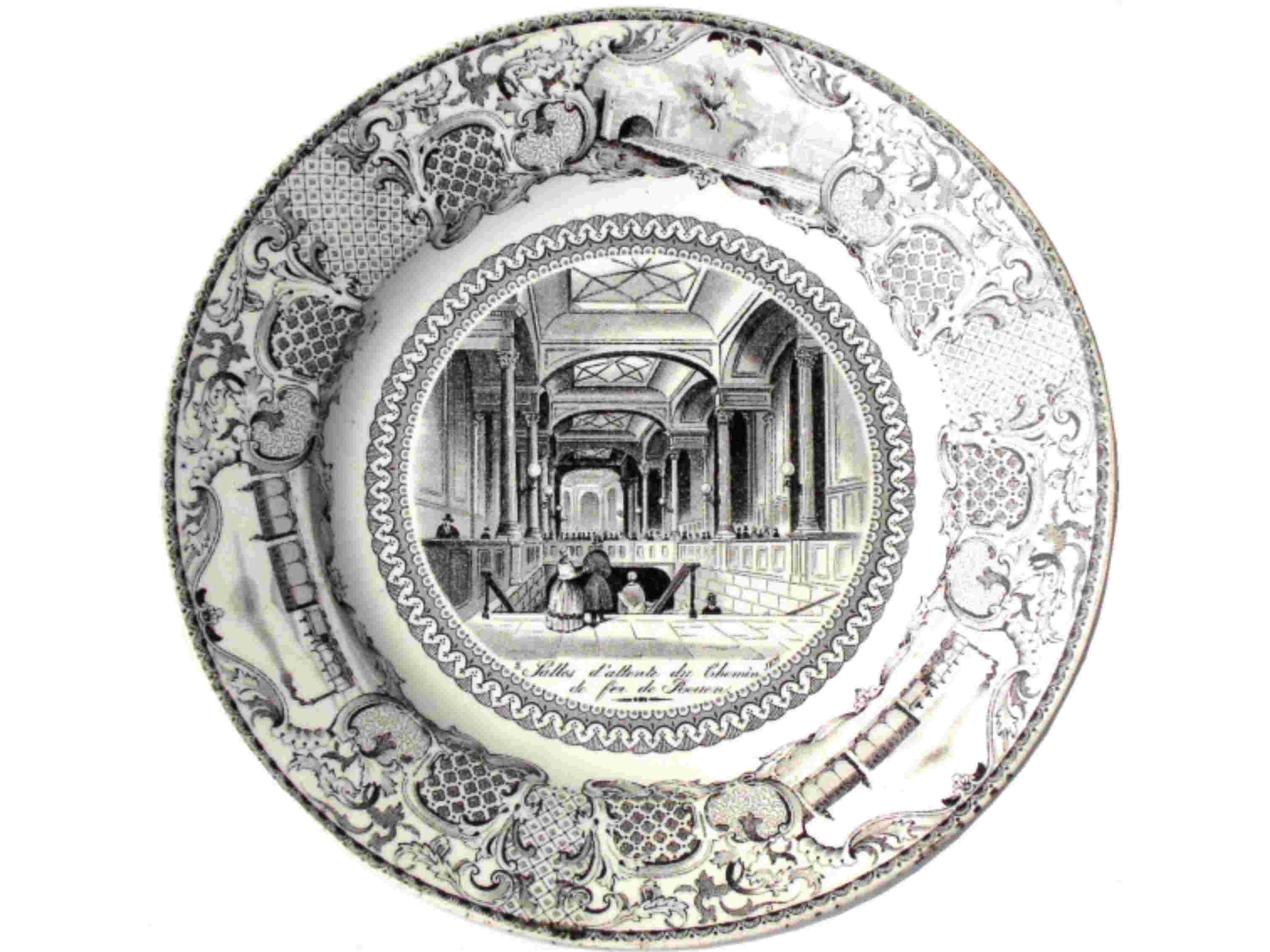
“Series of twelve plates produced in Gien between 1844 and 1851”, signed JBM, on the theme of railways from Paris to Rouen and Paris to Orléans

“Paris. Embarcadère », lithograph taken from a series of twenty lithographs by Provost “Les trains de plaisir: le touriste en chemin de fer, ligne de Paris à Versailles”

View of the interior of the old Saint-Lazare station around 1845, anonymous untitled painting, Carnavalet museum (cited by Bowie, 2003).
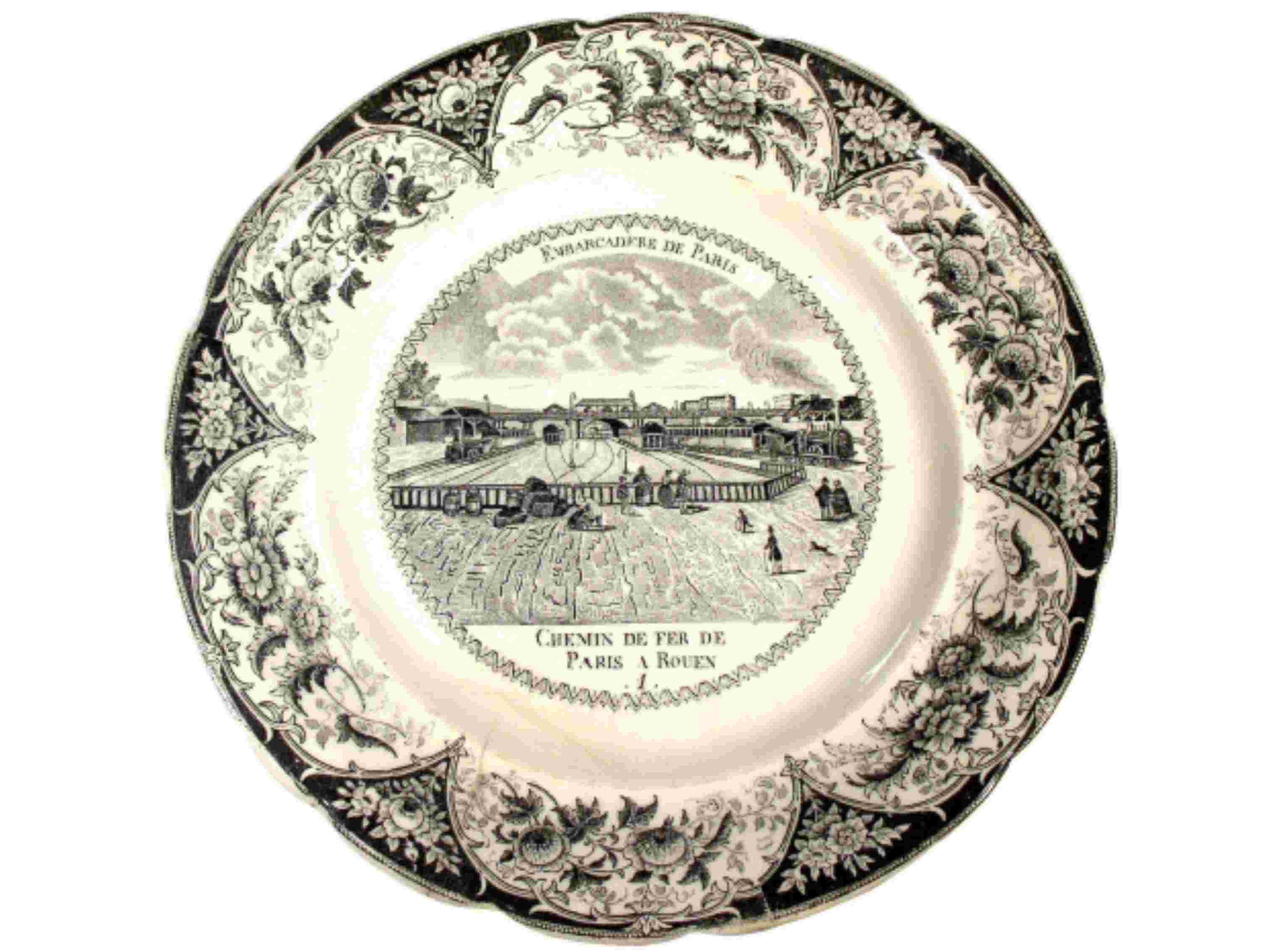
Series of twelve unsigned plates produced in Choisy between 1843 and 1863, on the theme of railways from Paris to Rouen and Paris to Orléans
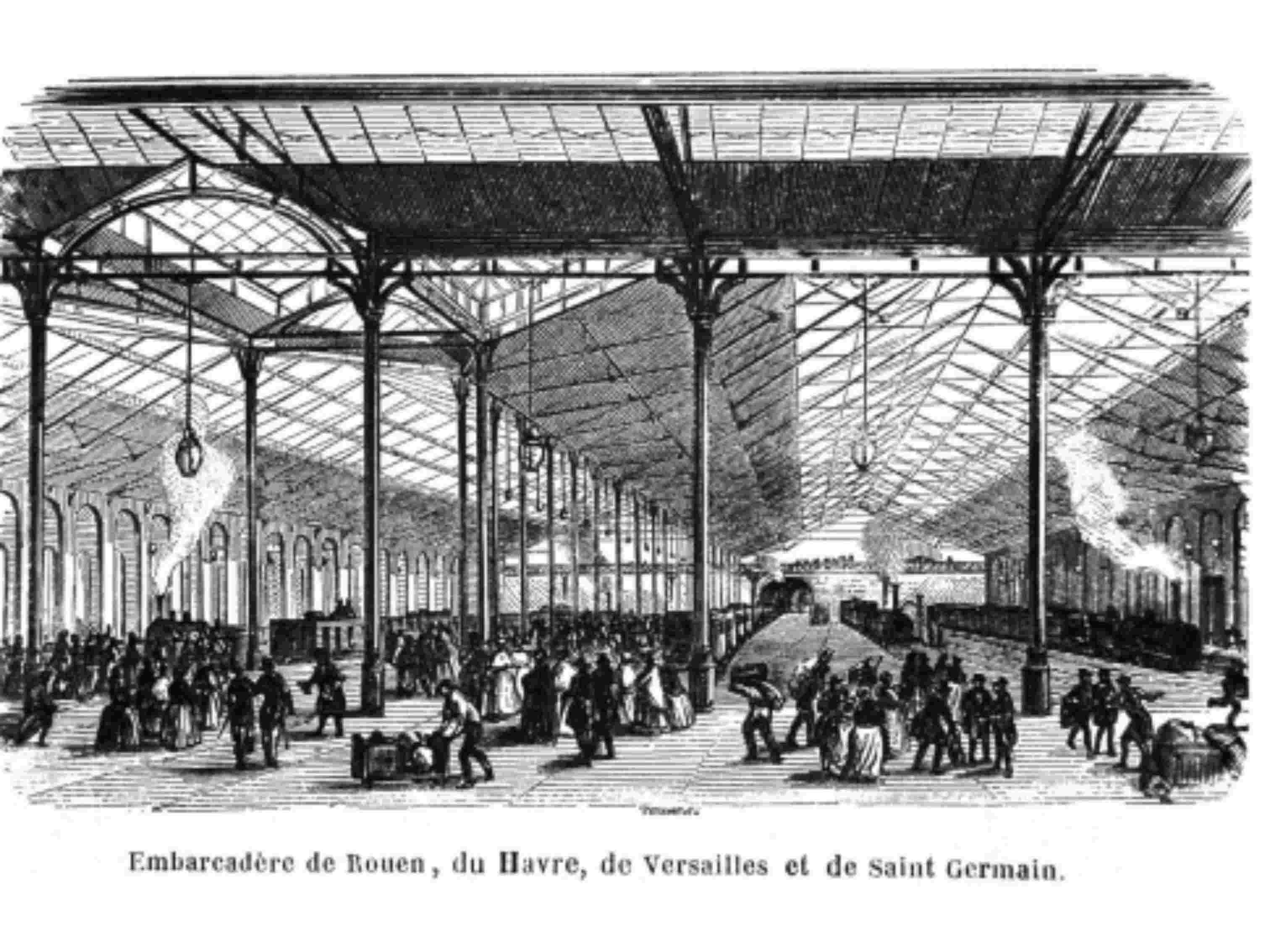
“Embarcadère de Rouen, du Havre, de Versailles et de Saint-Germain”, engraving on free-standing wood, engraved by Trichon
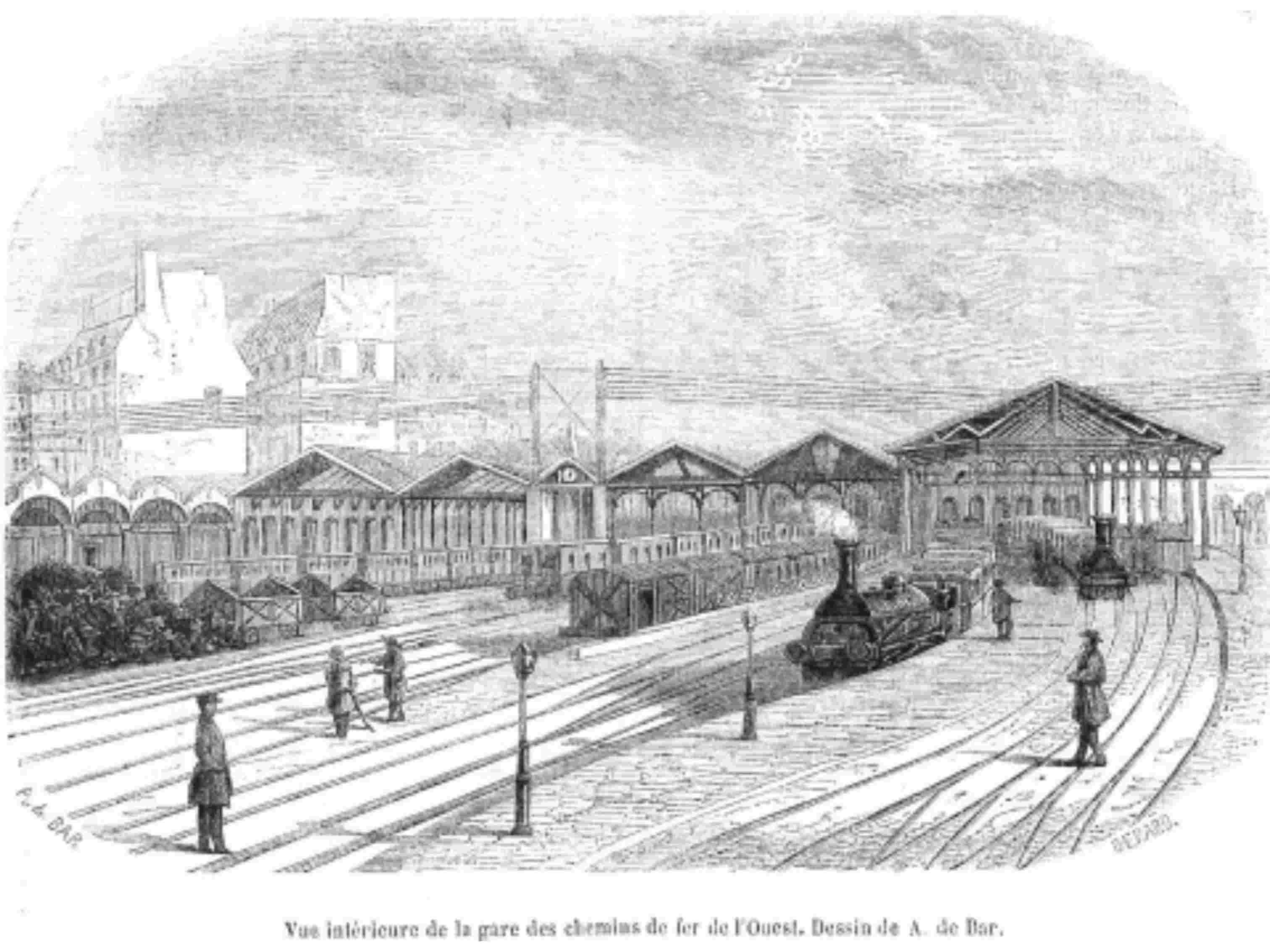
View of the interior of the Western Railway station, drawing by A. de Bar
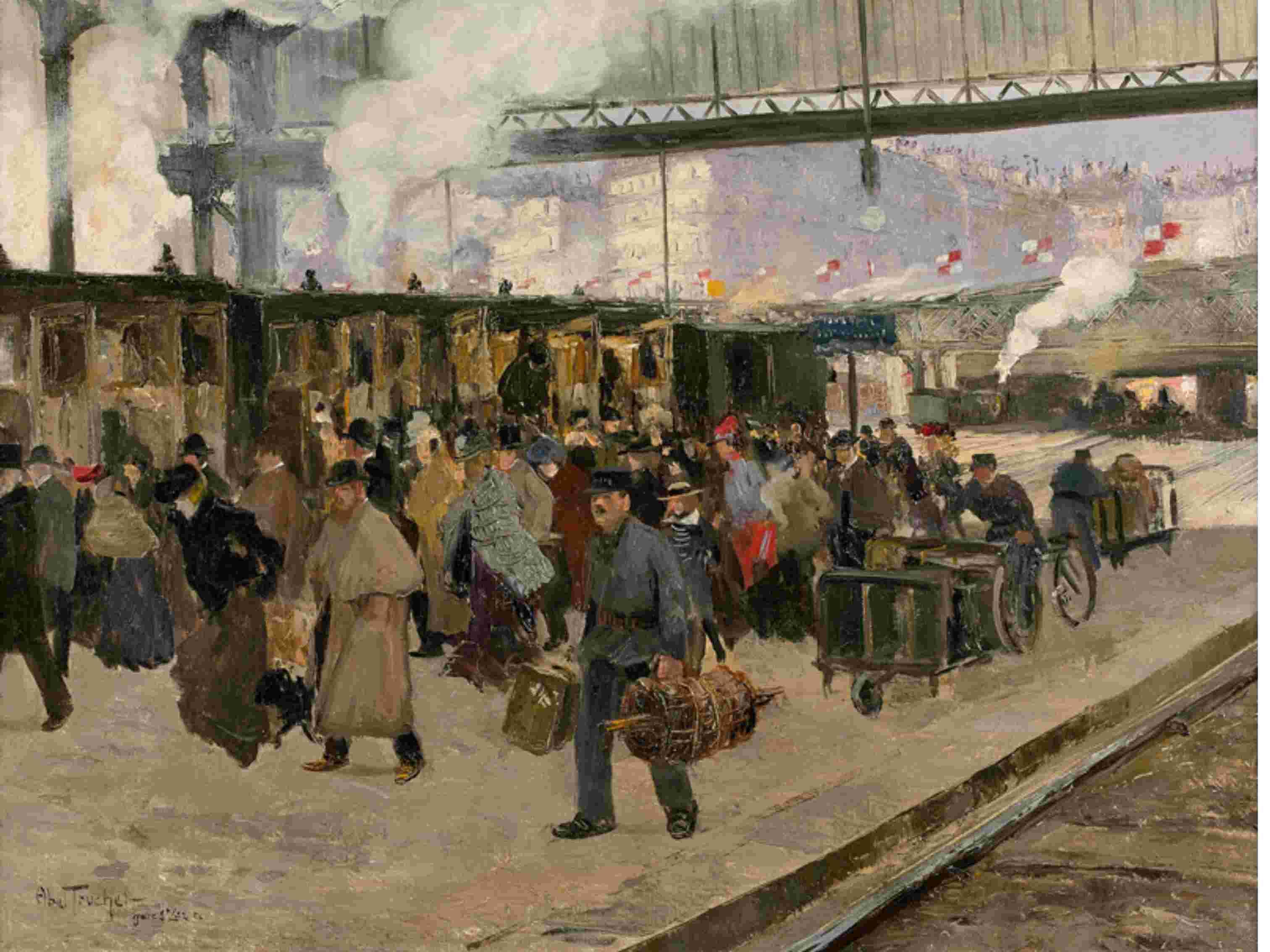
Louis Abel-Truchet, Gare Saint-Lazare (undated), oil on canvas - Germany, Private Collection
Claude Monet, artistic ambassador of the Gare Saint-Lazare
Monet was so inspired by the modern, dynamic nature of the station that he went to live nearby in 1877! The result was a , exhibited in museums and galleries all over the world. These works tell of the rise of the railway in the mid-19th century. The most well-known painting, “La Gare Saint-Lazare”, is now displayed in the Musée d’Orsay. Prime locations such as the Musée de Giverny, Musée des Impressionnistes, and Musée d’Orsay reveal secrets of Claude Monet's most beautiful paintings.
Claude Monet, one of the pioneers of impressionism, was known for his passion for representing light and atmospheric effects in his paintings. Among his many iconic series, the Gare Saint-Lazare in Paris occupies a special place.
The end of the 19th century was marked by a rapid development of railways in Europe, transforming cities and ways of life. The Gare Saint-Lazare in Paris was one of the main railway stations of the time, and the first in Île-de-France. Monet was inspired by the dynamic, vibrant nature of this new facet of modern culture, and in 1877 he took up residence just a short distance away, visiting the station every day to explore its themes and reproduce this world through paintings.
Variations in light and atmosphere
In this series of 12 paintings of the Gare Saint-Lazare, Monet seeks to capture the multiple changes in light and atmosphere throughout the day. He often paints from a window in the hotel opposite the station, from where he could observe the changing play of light created by smoke coming out of the trains, clouds of steam and reflections on the railway tracks.
Recurring themes
Certain elements are repeated throughout the series of 12 works: smoke gushing from steam trains, hurried passengers, busy tracks and platforms. However, Monet changes the composition and palette of colours from one painting to the next, thus creating different moods and the sense of constant movement.
Impressionist experimentation
The Gare Saint-Lazare series is an excellent example of Monet’s impressionist approach. He uses quick, visible brush strokes to capture the essence of the scene rather than concentrating on precise details. Colours are often applied in adjacent strokes, enabling the viewer's eye to blend the hues and create an overall impression.
La représentation de la modernité
In choosing to paint the Gare Saint-Lazare, Monet seizes the spirit of the modern era and growing urbanisation. He was fascinated by the idea of capturing the energy of the city in motion and paying tribute to the development of rail transport. Locomotive chimneys almost become symbols of industrial progress.
Artistic heritage
The Gare Saint-Lazare series by Monet had a significant impact on modern art. His bold compositions, effects of light and depiction of contemporary themes paved the way for many later artists. His artistic freedom and innovative vision also inspired impressionist painters and artists in later movements such as futurism and cubism.
The Gare Saint-Lazare – 1877
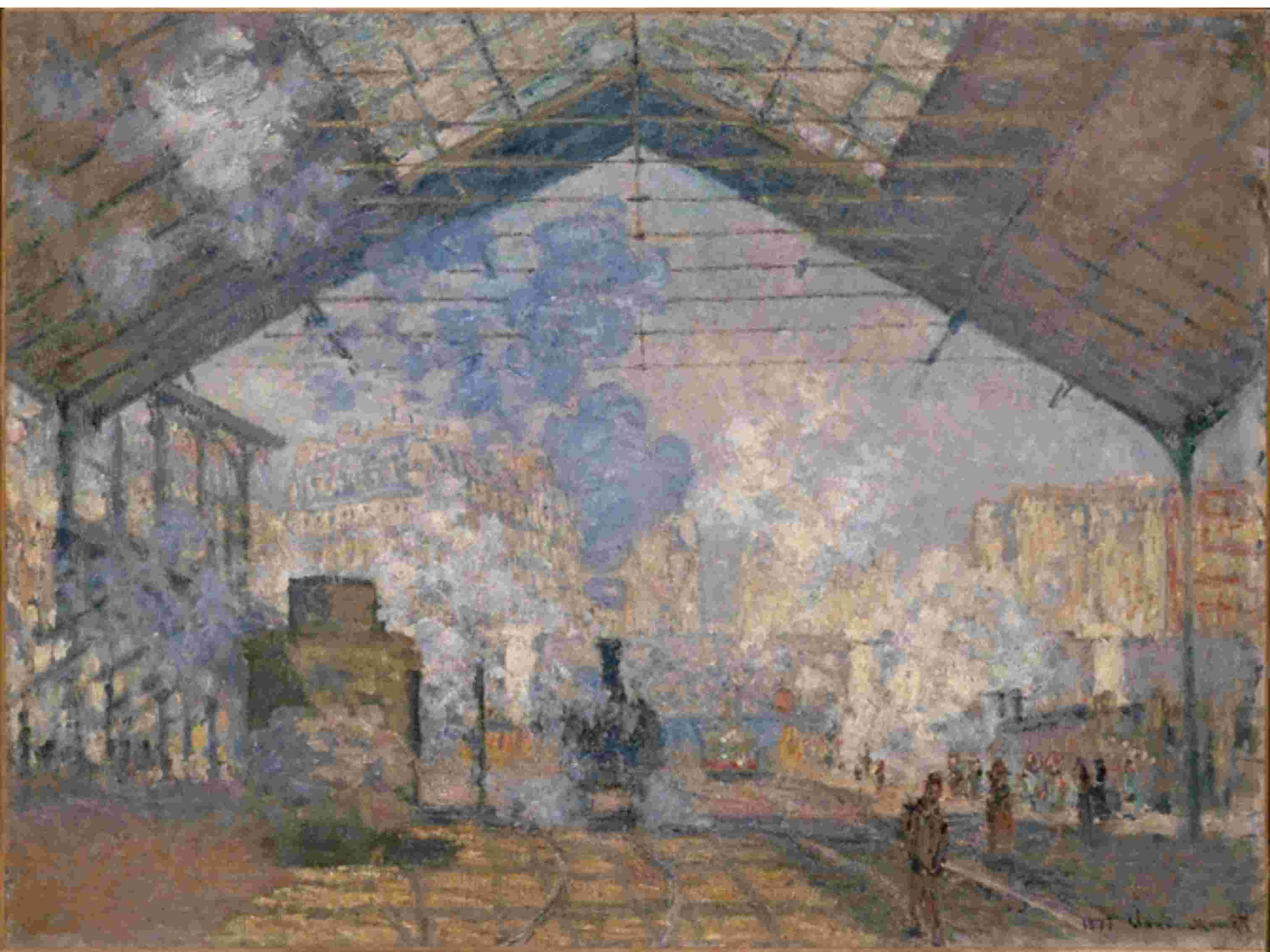
Claude Monet
The Gare Saint-Lazare
In 1877
Oil on canvas
H. 75.0; L. 105.0 cm.
Musée d’Orsay, Paris, France
© Musée d’Orsay, Dist. RMN-Grand Palais / Patrice Schmidt
La Gare Saint-Lazare, Arrivée d’un train – 1877
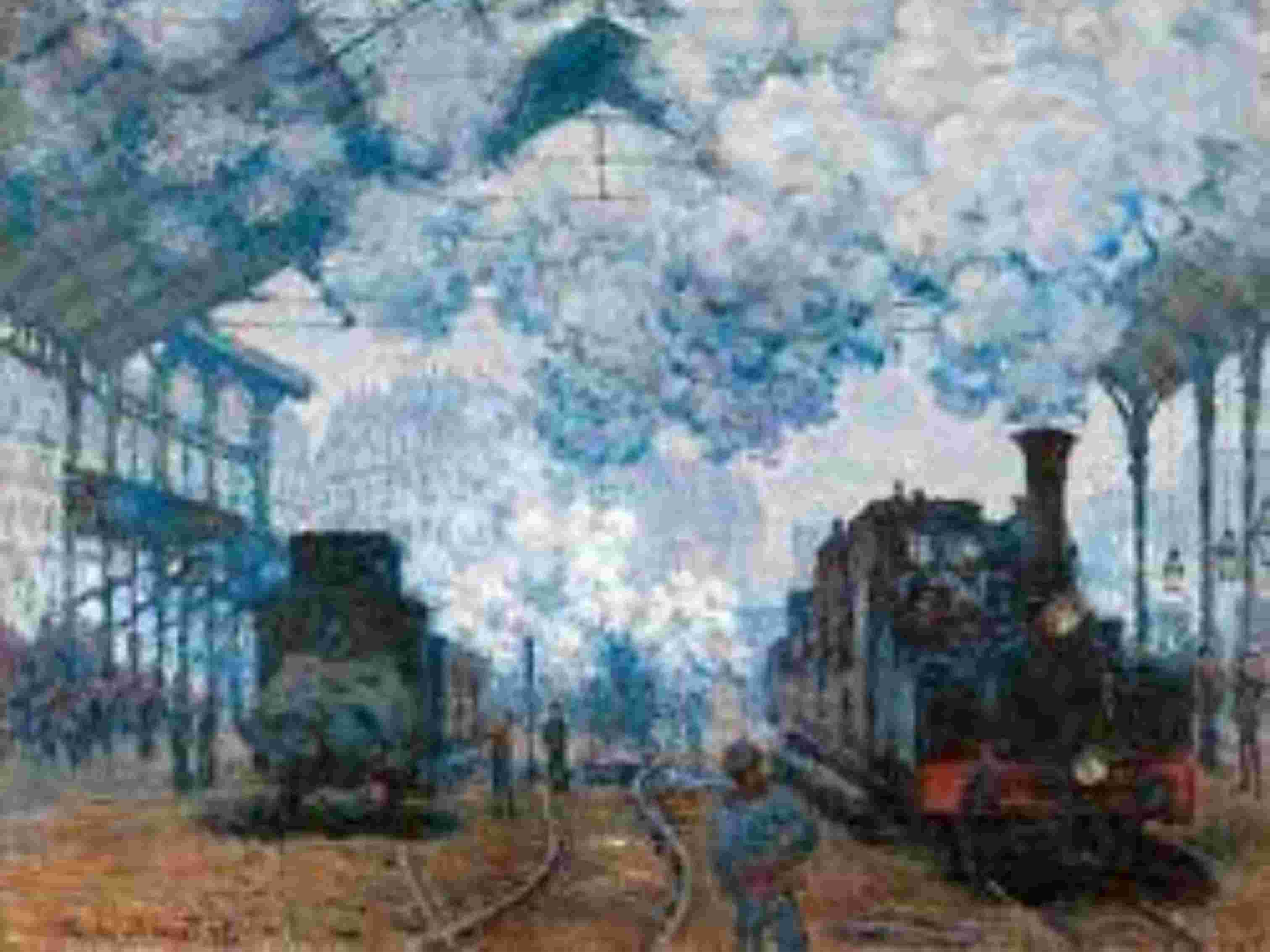
Claude Monet
La Gare Saint-Lazare et l’arrivée d’un train
In 1877
H. 83.0; L. 101.3 cm.
Fogg Art Museum, Cambridge, United States.
© President and Fellows of Harvard College
La Gare Saint-Lazare, arrivée du train de Normandie – Claude Monet – 1877
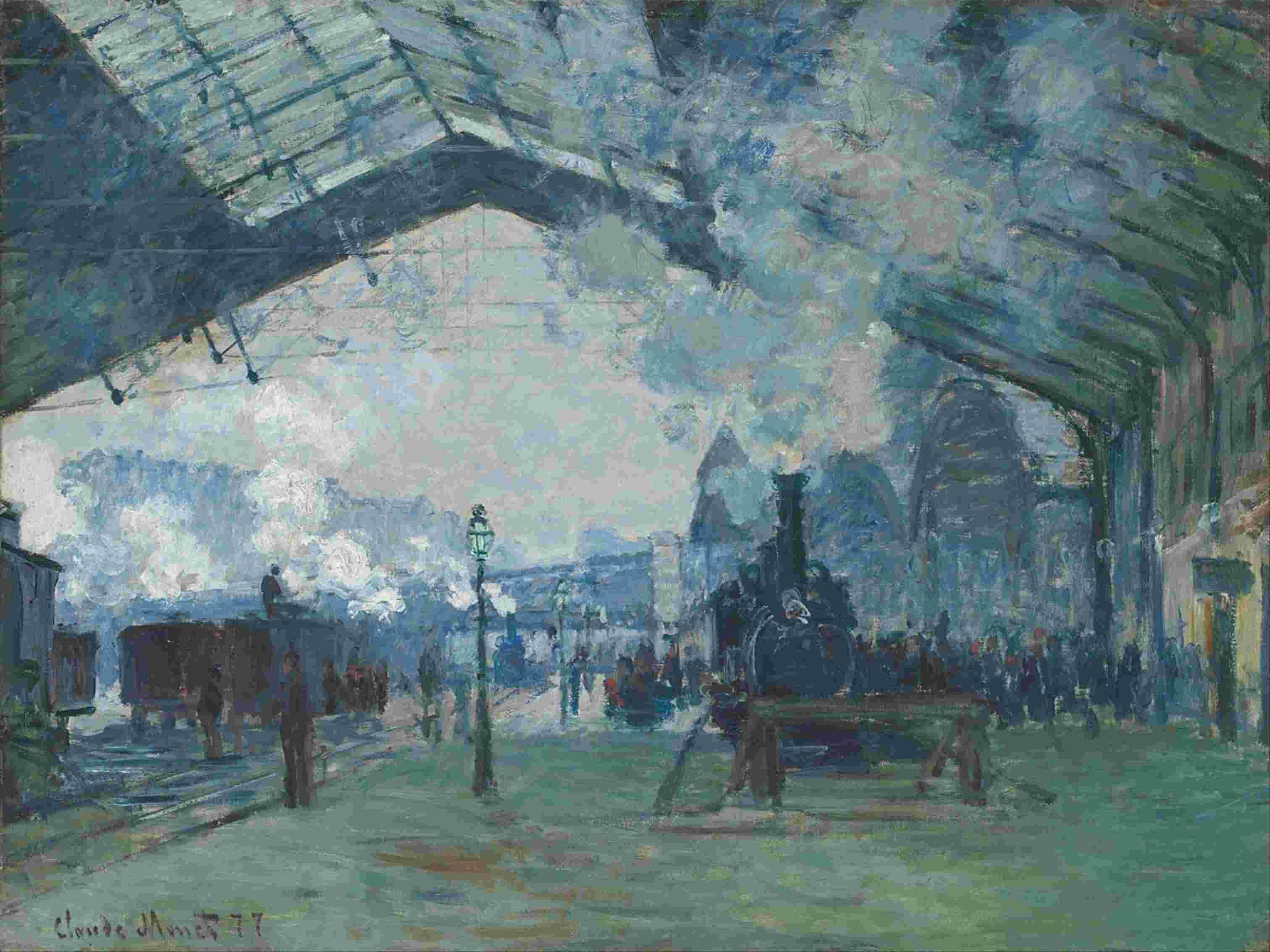
Claude Monet
La Gare Saint-Lazare, arrivée du train de Normandie
In 1877
H. 60.3; L. 80.2 cm.
Art Institute Chicago, Chicago, United States
The Gare Saint-Lazare – Claude Monet – 1877
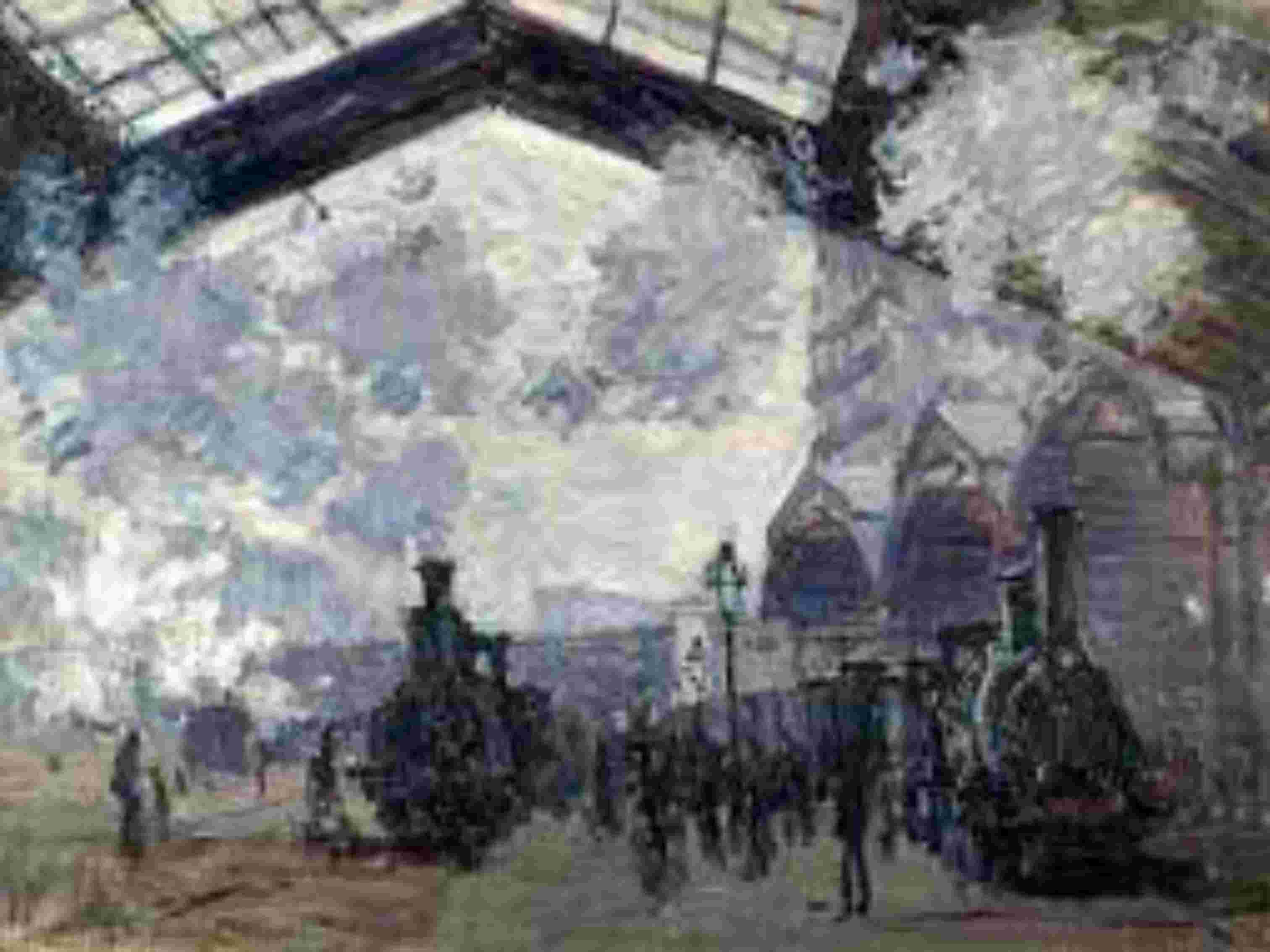
Claude Monet
The Gare Saint-Lazare
In 1877
H. 54.3; L. 73.6 cm.
National Gallery, London, United Kingdom
Le Pont de l'Europe, gare Saint-Lazare – Claude Monet – 1877
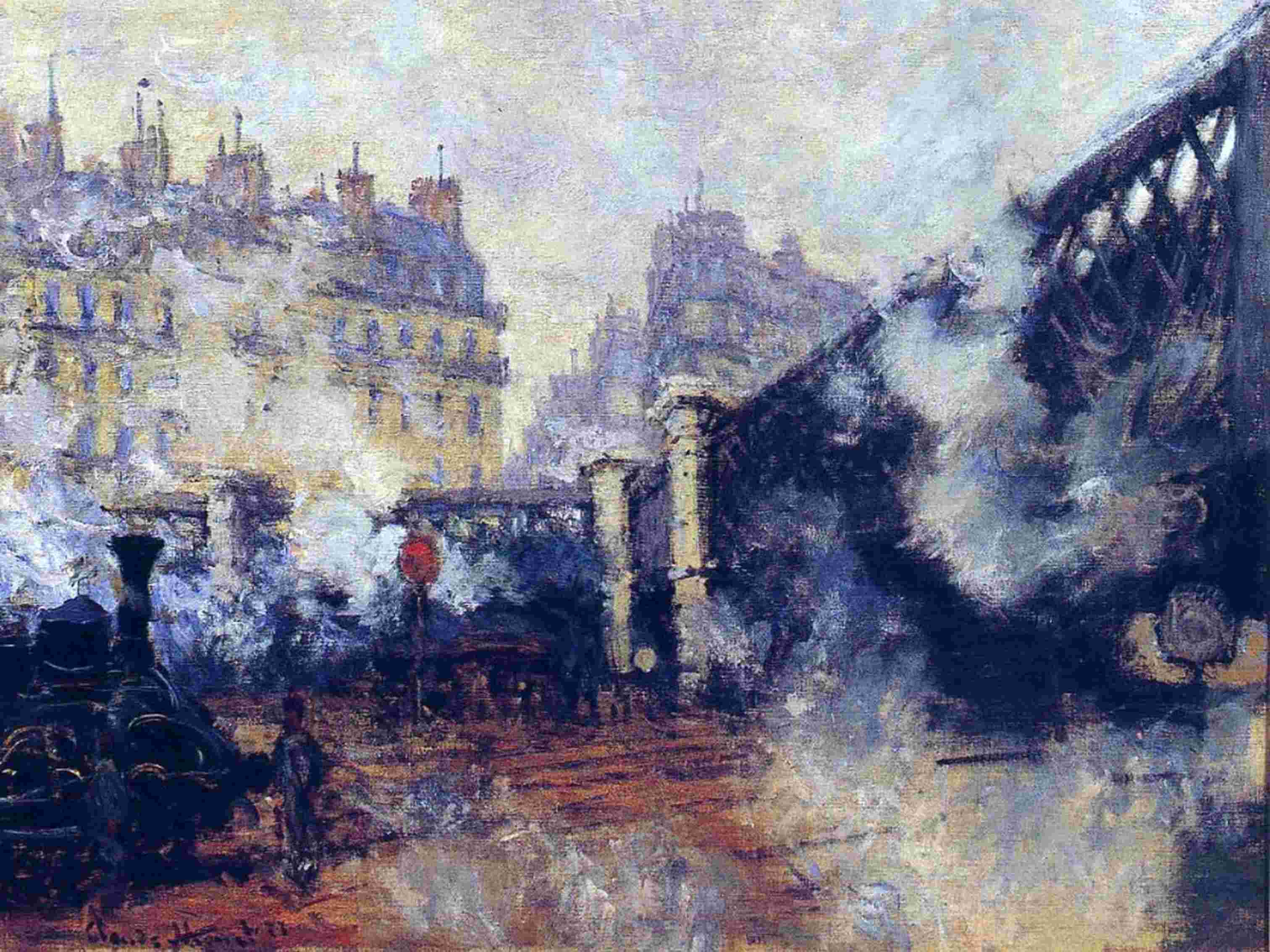
Claude Monet
Le Pont de l'Europe, gare Saint-Lazare
In 1877
H. 65; L. 81 cm.
Musée Marmottan Monet, Paris, France.
Extérieur de la gare Saint-Lazare, effet de soleil – Claude Monet – 1877
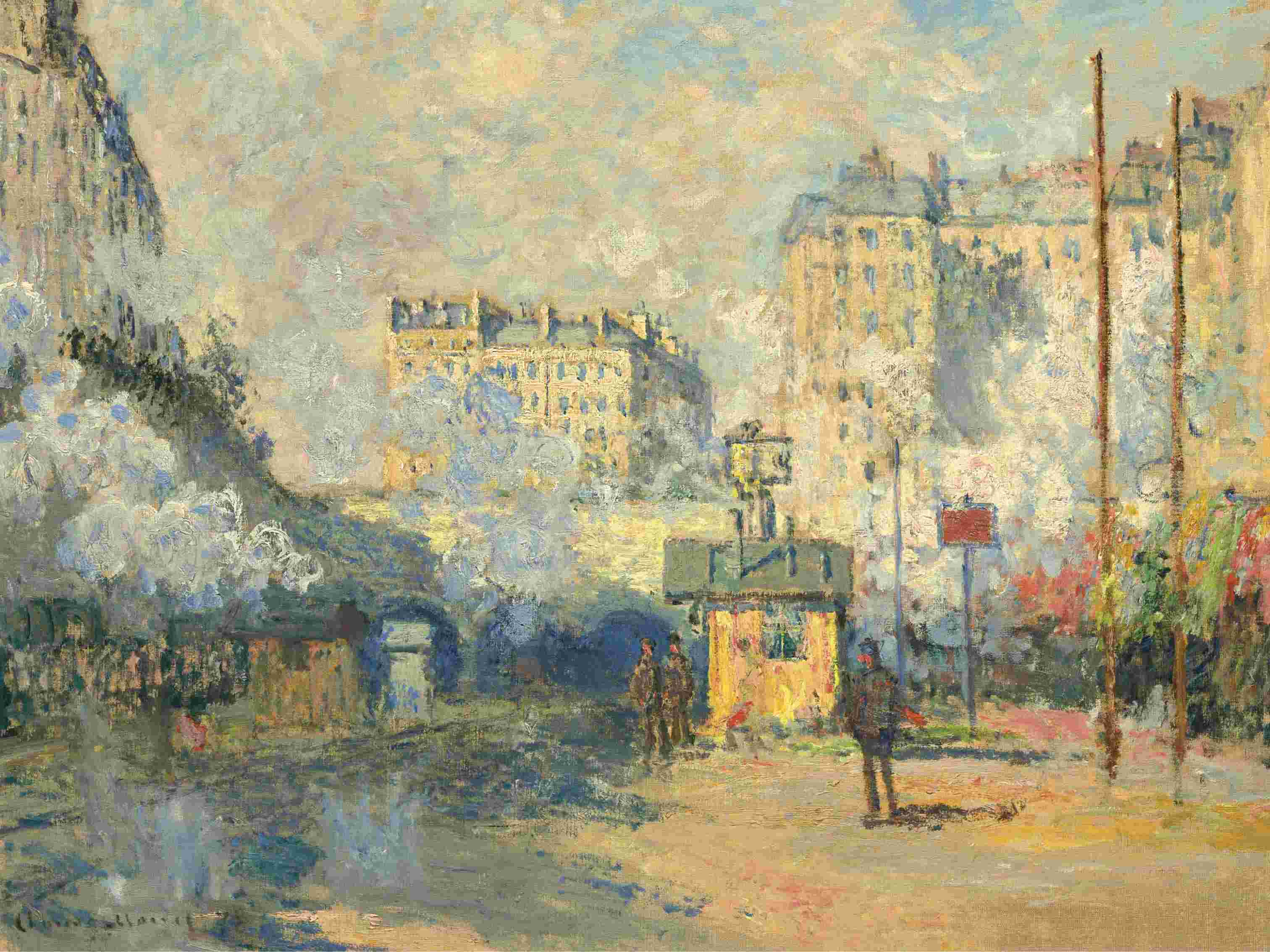
Claude Monet
Extérieur de la gare Saint-Lazare, effet de soleil
In 1877
H. 60; L. 81 cm.
Private collection
Extérieur de la gare Saint-Lazare, arrivée d’un train – Claude Monet – 1877

Claude Monet
Extérieur de la gare Saint-Lazare, arrivée d’un train
In 1877
H. 60; L. 72 cm.
Private collection
Les Voies à la sortie de la gare Saint-Lazare– Claude Monet – 1877
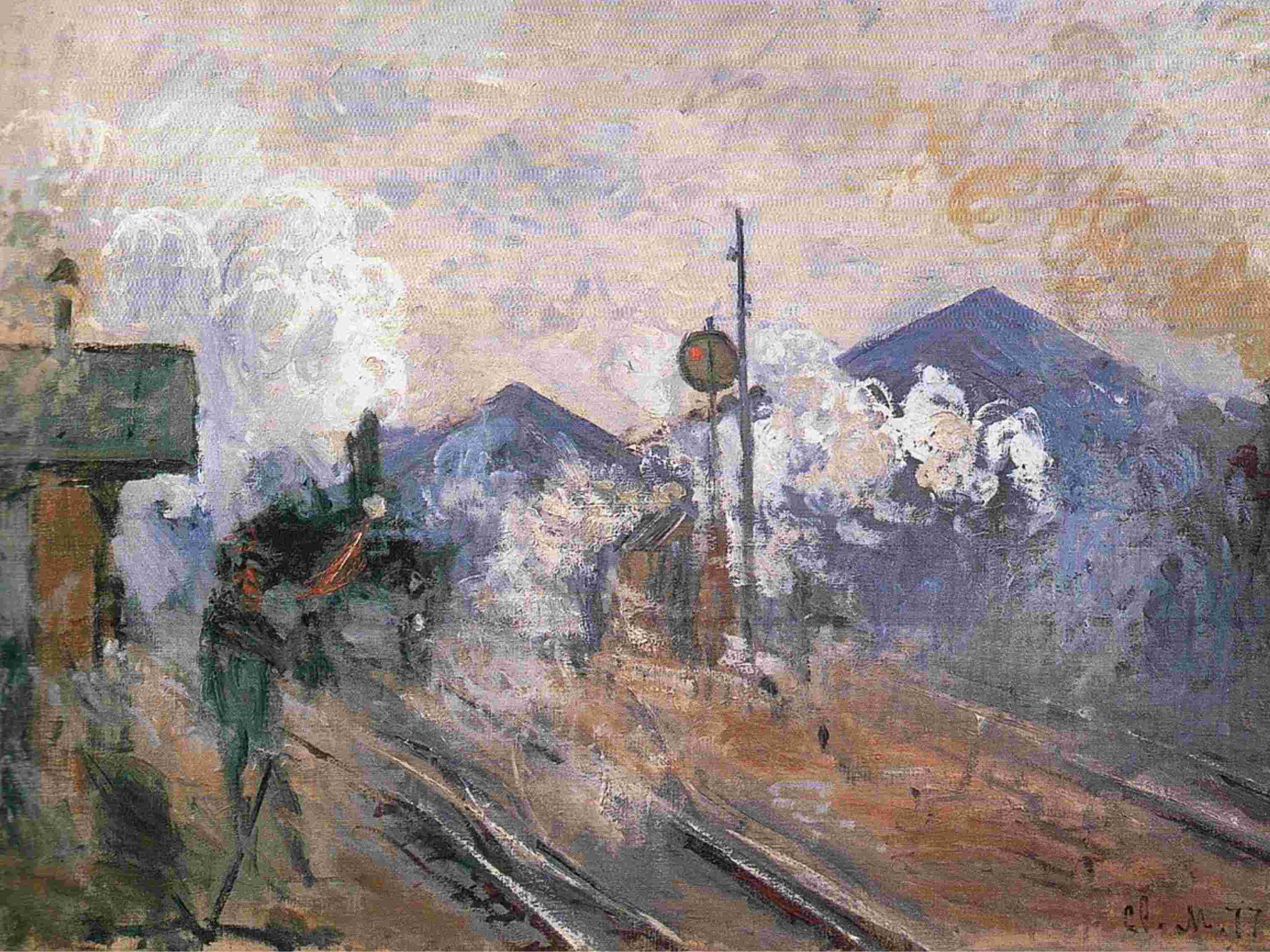
Claude Monet
Les Voies à la sortie de la gare Saint-Lazare
In 1877
H. 60; L. 80 cm.
Pola Museum of Art, Hakone, Japon
La Gare Saint-Lazare, vue extérieure– Claude Monet – 1877
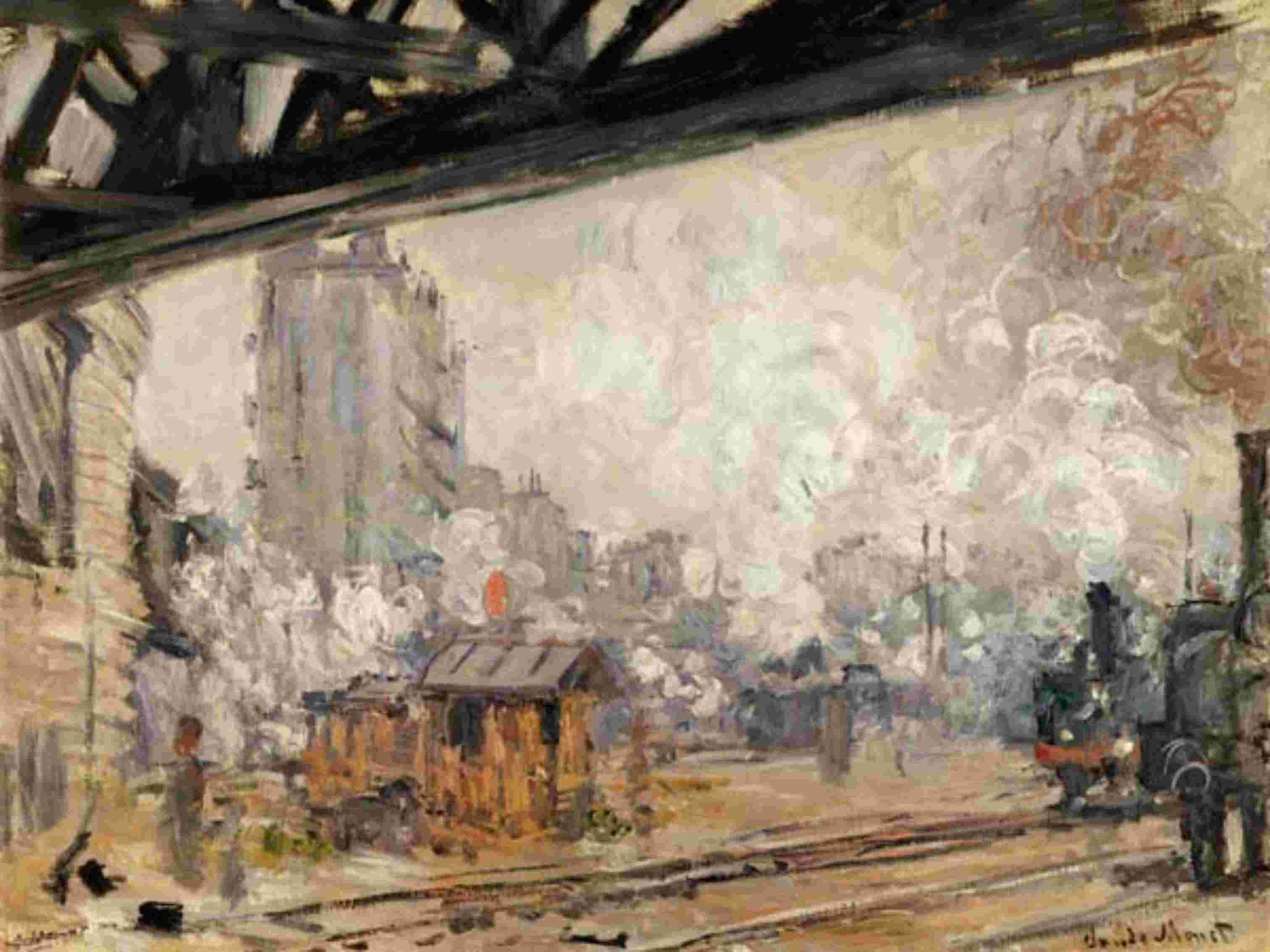
Claude Monet
La Gare Saint-Lazare, vue extérieure
In 1877
H. 64; L. 81 cm.
Private collection
La Gare Saint-Lazare, vue extérieure – Claude Monet – 1877
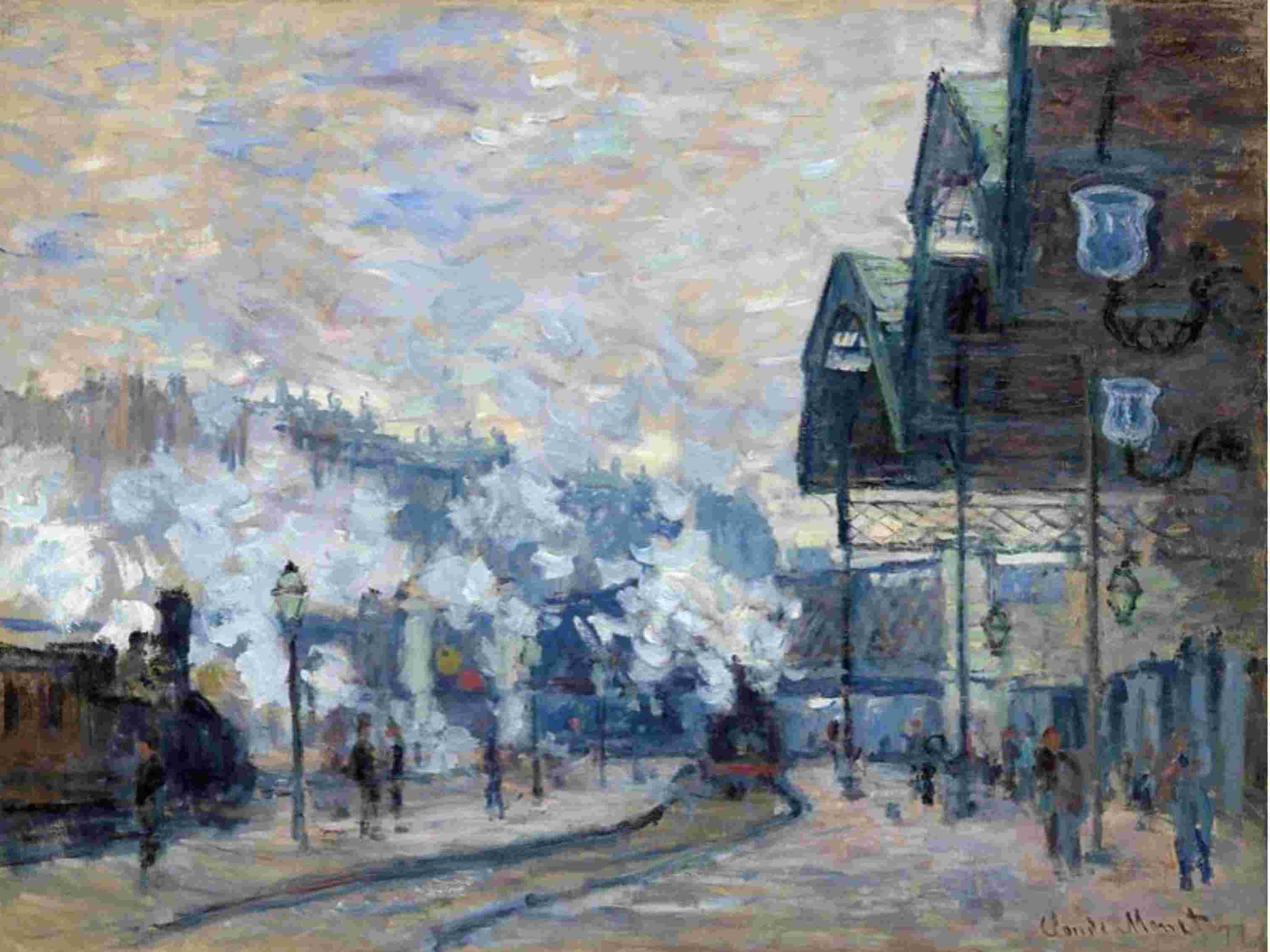
Claude Monet
La Gare Saint-Lazare, vue extérieure
In 1877
H. 60; L. 80 cm.
Private collection
La Gare Saint-Lazare, les signaux ou Le Signal– Claude Monet – 1877
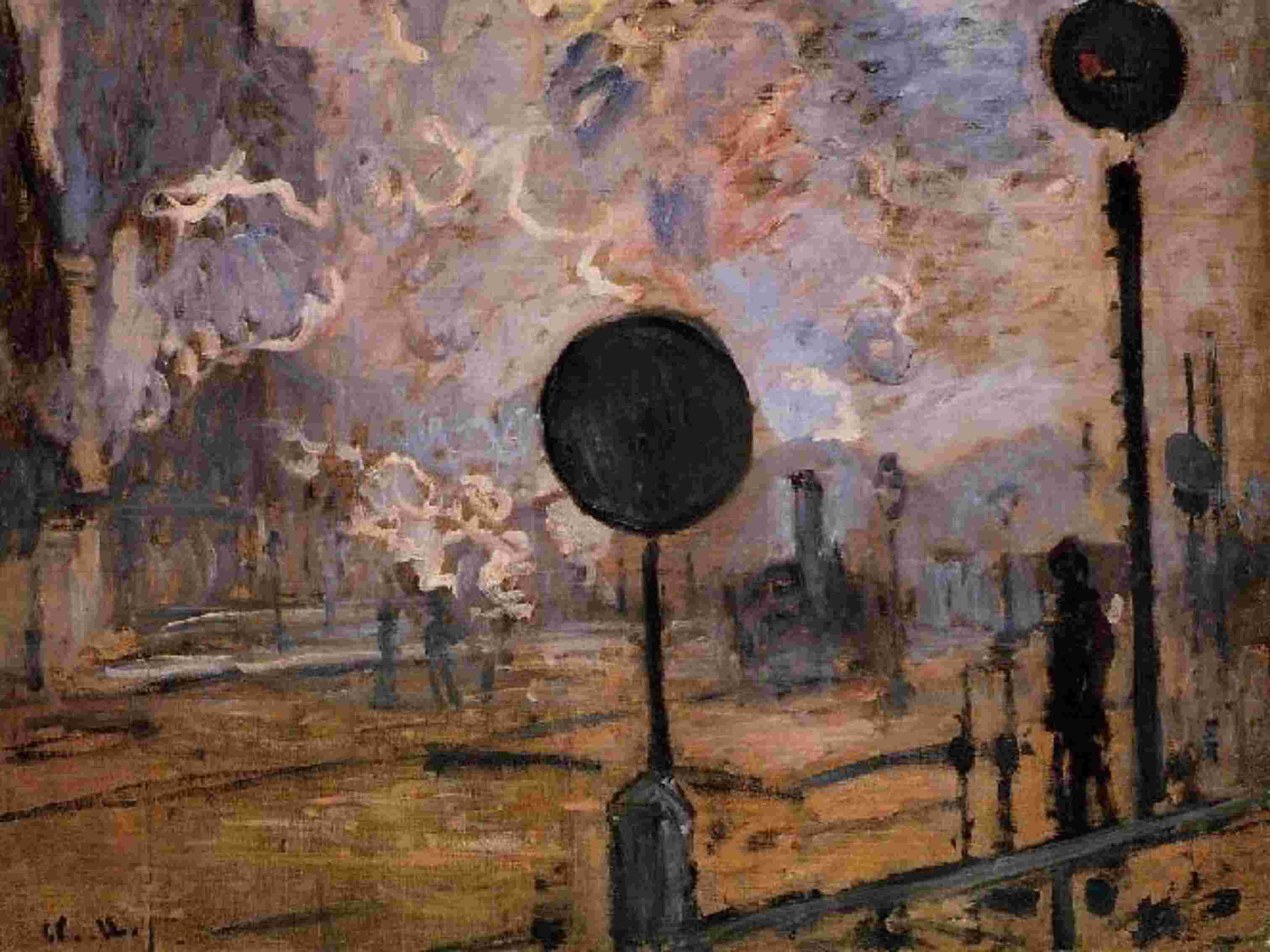
Claude Monet
La Gare Saint-Lazare, les signaux ou Le Signal
In 1877
H. 65; L. 81 cm.
Lower Saxony State Museum, Hanover, Germany
La Tranchée des Batignolles– Claude Monet – 1877
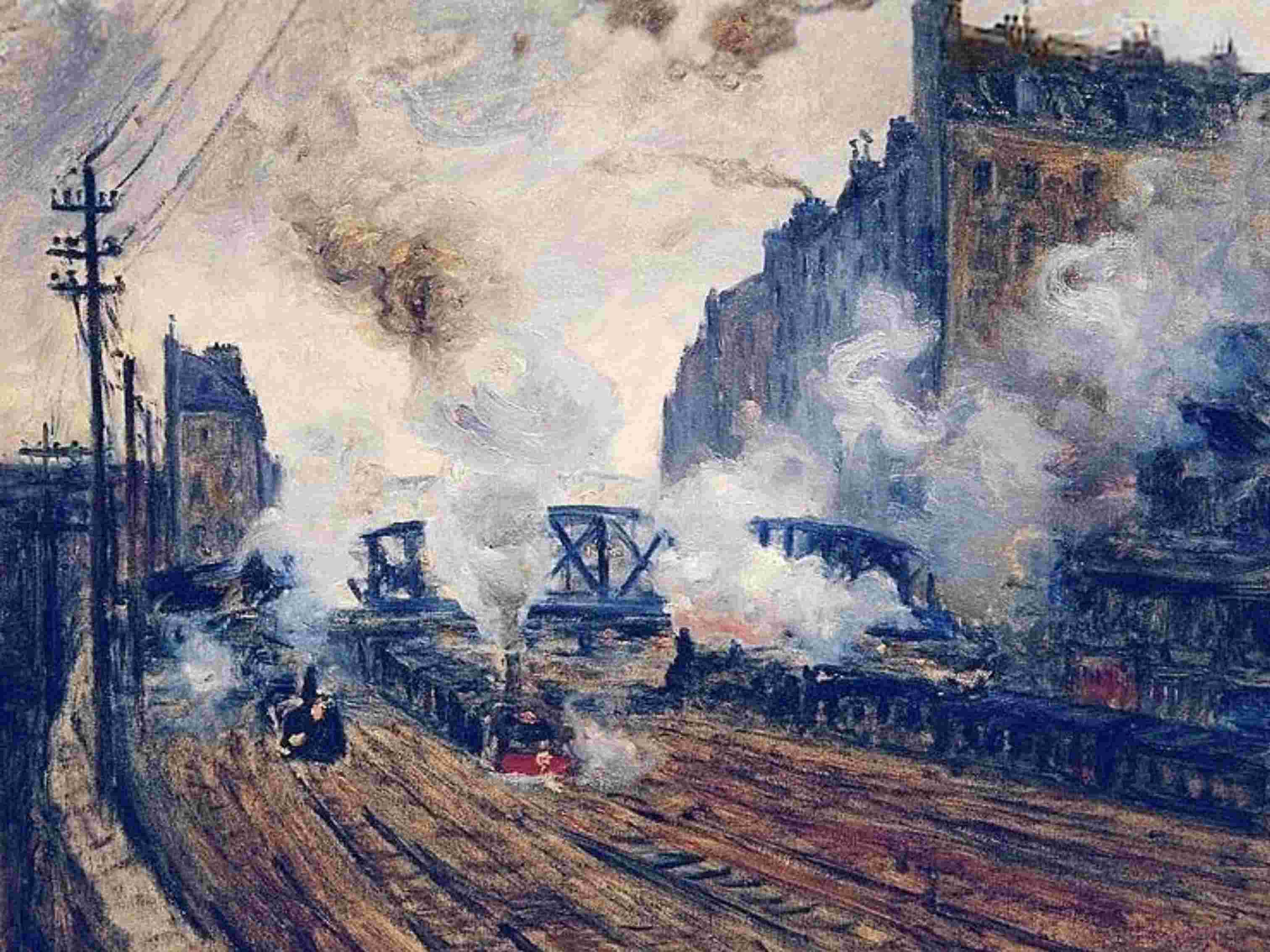
Claude Monet
La Tranchée des Batignolles
In 1877
H. 38; L. 46 cm.
Wurth Collection, Rome, Italy
Look around you...see the decorative windows
From ornamental glass dating back to 1930 to eclectic works installed throughout the station, heighten your artistic senses while strolling through the Gare Saint-Lazare!
The decorative windows, an artistic feature of the station and shopping centre
The 114 Art Nouveau decorative windows that adorn the interior façade of the station and the shopping centre date back to 1930. They were restored over six years, between 2005 and 2011, by the painter and sculptor, Charles Sarteur, who was also a railwayman. The motifs represent tourist sites and destinations served by the railway network of the time. In addition to their artistic and decorative qualities, some also have historic and documentary significance. This is especially true of the one dedicated to the town of Poissy, in Yvelines, where the bridge depicted was destroyed during the 1944 bombings of the Second World War.
Don't be surprised to find Zurich and Saint-Petersburg among the cities featured at the end on the rue de Rome side: these windows were created much more recently, in 2011, to acknowledge the relationship and collaboration between Saint-Lazare and these two stations. Since 2010, the Gare Saint-Lazare has been twinned with the Gare de la Baltique, in Saint-Petersburg.
art exhibitions at the Gare Saint-Lazare
The Gare Saint-Lazare has hosted complimentary exhibitions with the aim of promoting art through different spaces and giving visibility to the various museums.
In particular, museums accessible viadirect lines going from the Gare Saint-Lazare
to popular destinations in France and Europe. For example:
- The exhibition of the Franciscan women, paying tribute to the André Malraux museum in Hamburg;
- The temporary exhibition “Sur les chemins du paradis”, bringing visibility to Deauville, which has a direct connection to the Gare Saint-Lazare;
- The exhibition “Les femmes s’exposent”, in 2023, which displayed several photos typical of the Norman cultural event. “Les femmes s’exposent” is a photography festival that takes place in Houlgate from August to September. Thanks to its direct access to western France, the Gare Saint-Lazare pays tribute to this region overflowing with art and history.
- In 2022, the Horizon Forbidden West exhibition at the exit of the Gare Saint-Lazare metro received a favourable response.
The Art Ludique museum in 2024
The Art Ludique museum is the first museum in the world dedicated to creative industries. This museum aims to promote the work of creators who have made their mark on our imagination and 21st century culture. The Art Ludique museum was initially located in the City of Fashion and Design, which was closed down in 2017. The Gare Saint-Lazare is now bringing it back to life! The museum takes place behind the large clock, in a space of over 1300 square metres. The project was set to open in 2021, but the Art Ludique museum should finally take place inside the station during 2024. The public will then have a chance to discover the world of video games, animated films, comics, manga, and even design and cinema. Thanks to groundbreaking technology, we are also discovering new ways of learning art, with an exhibition eagerly awaited by all Parisians!
Artistic hide and seek at Saint-Lazare
the work of Levalet
In addition to its historic windows, the Gare Saint-Lazare harbours other artistic gemshidden in the Gare Saint-Lazare shopping centre. The modern, inspiring work of the artist Levalet, whose style you may recognise in other French stations, has taken over the four corners of the Gare Saint-Lazare. “Concrete Jungle, sous le béton, la jungle”; “Le Bureau des Plaintes” and “Ontogenèse”. The different pieces of work have been painted on the theme of travel, and invite visitors to escape through the different tracks of the Gare Saint-Lazare, and through these paintings.
The paintings are presented as a comic strip with characters drawn in Indian ink, and recount a story of freedom and escape. Keep your eyes peeled - there are more surprises than you might think…

Concrete Jungle, sous le béton la jungle – Levalet - ©SNCF Gares & Connexions
Le Bureau des Plaintes – Levalet - ©SNCF Gares & Connexions

Ontogenèse – Levalet - ©SNCF Gares & Connexions
Prendre de la hauteur – Levalet - ©SNCF Gares & Connexions
The work of Kan
Directly inspired by Claude Monet, the most iconic impressionist of the Gare Saint-Lazare, the artist Kan, for his part, brought the pillars of tracks 8/9 to life in his work "Les Coquelicots". At first glance, one sees a series of hypnotising dots, sometimes forming a face, sometimes a landscape.
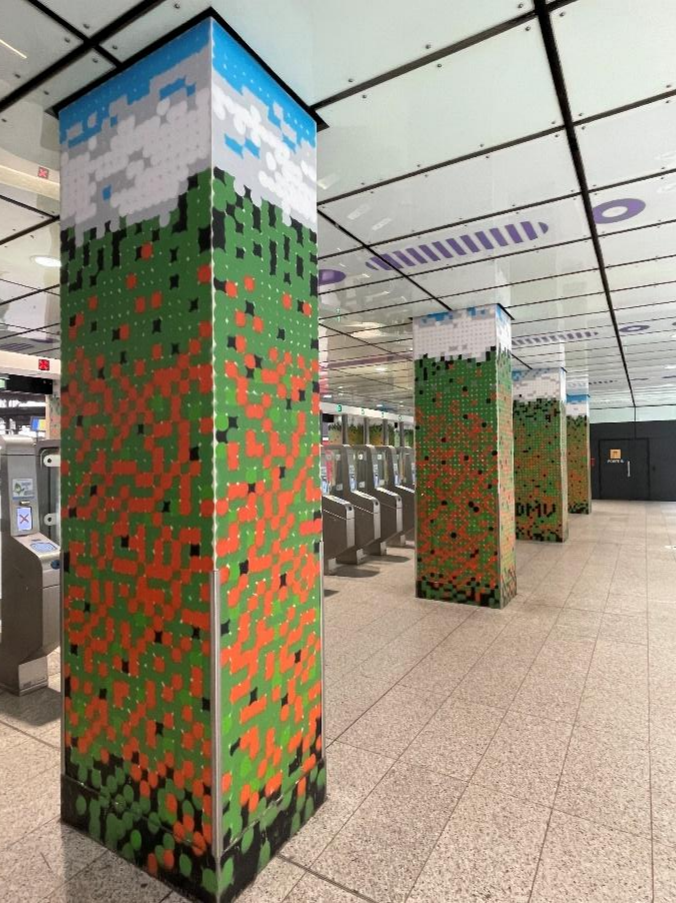
Les Coquelicots – Kan - ©SNCF Gares & Connexions
Museums near the Gare Saint-Lazare
If you are looking for exhibitions and museums in Paris, you’ve come to the right place.
On leaving the Gare Saint-Lazare, you can visit and immerse yourself in a variety of cultural sites:
- The “At the court of Prince Genji” exhibition at the Guimet museum – 10 minutes by public transport, lines 13 and 9.
- Or the Nathan Sawaya exhibition “Art of the Brick”, the well-known exhibition of Lego in France - 20 minutes on lines 13 or 12.
- The Louvre, whose artwork spans several periods of history and has an outstanding collection of exhibits on the subject of ancient Egypt and Tutankhamun – 10 minutes on line 14.
- The Palais de Tokyo - 20 minutes on line 9.
- The Montmartre museum exhibits the work of an unknown artist, Auguste Herbin – 20 minutes on line 12.
Places less than 20 minutes on foot:
- Grévin museum
- Opéra Garnier
- Gustave Moreau museum
- Musée de la Vie Romantique
- Cernuschi museum - Musée des arts de l'Asie de la Ville de Paris

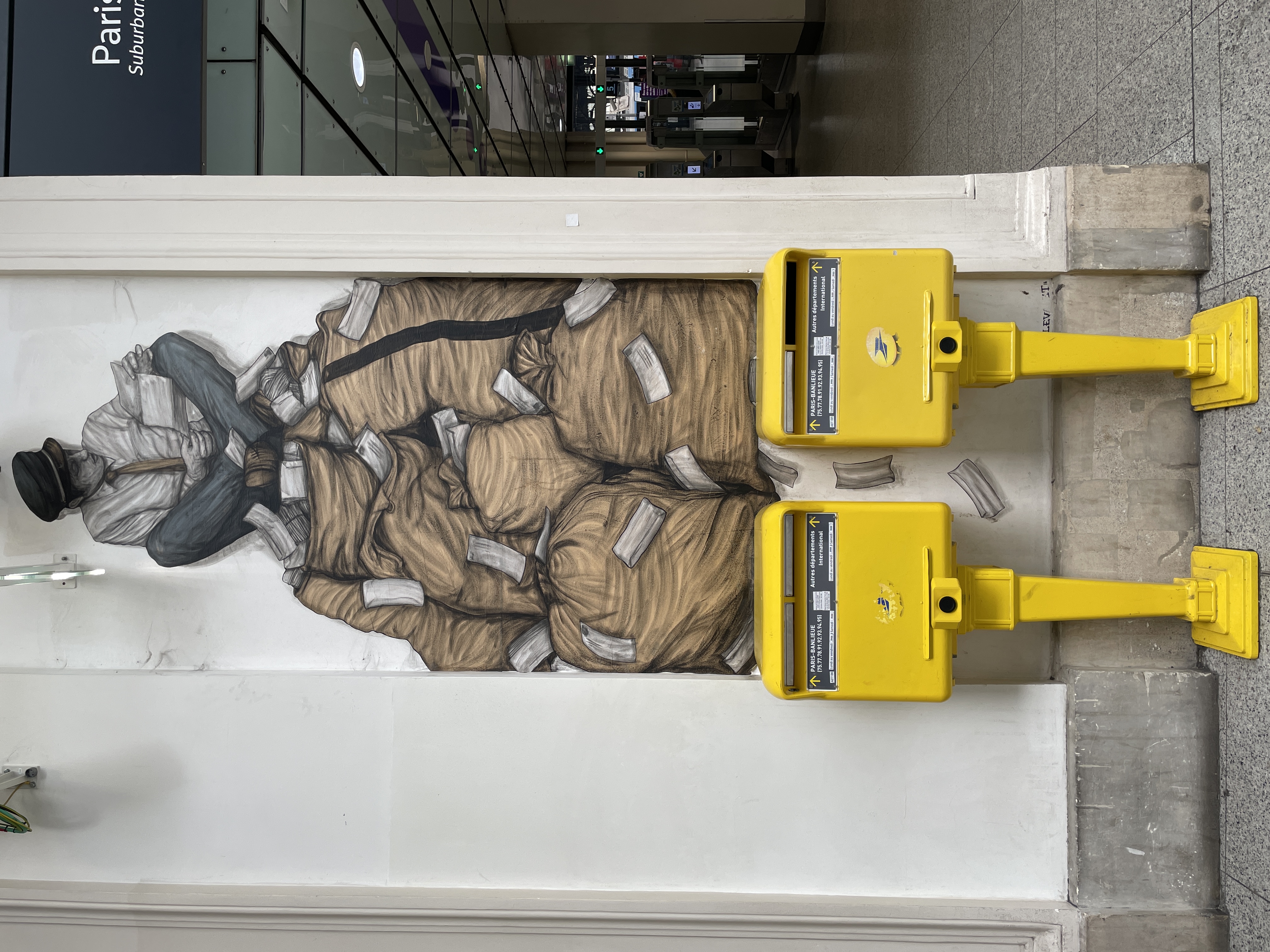
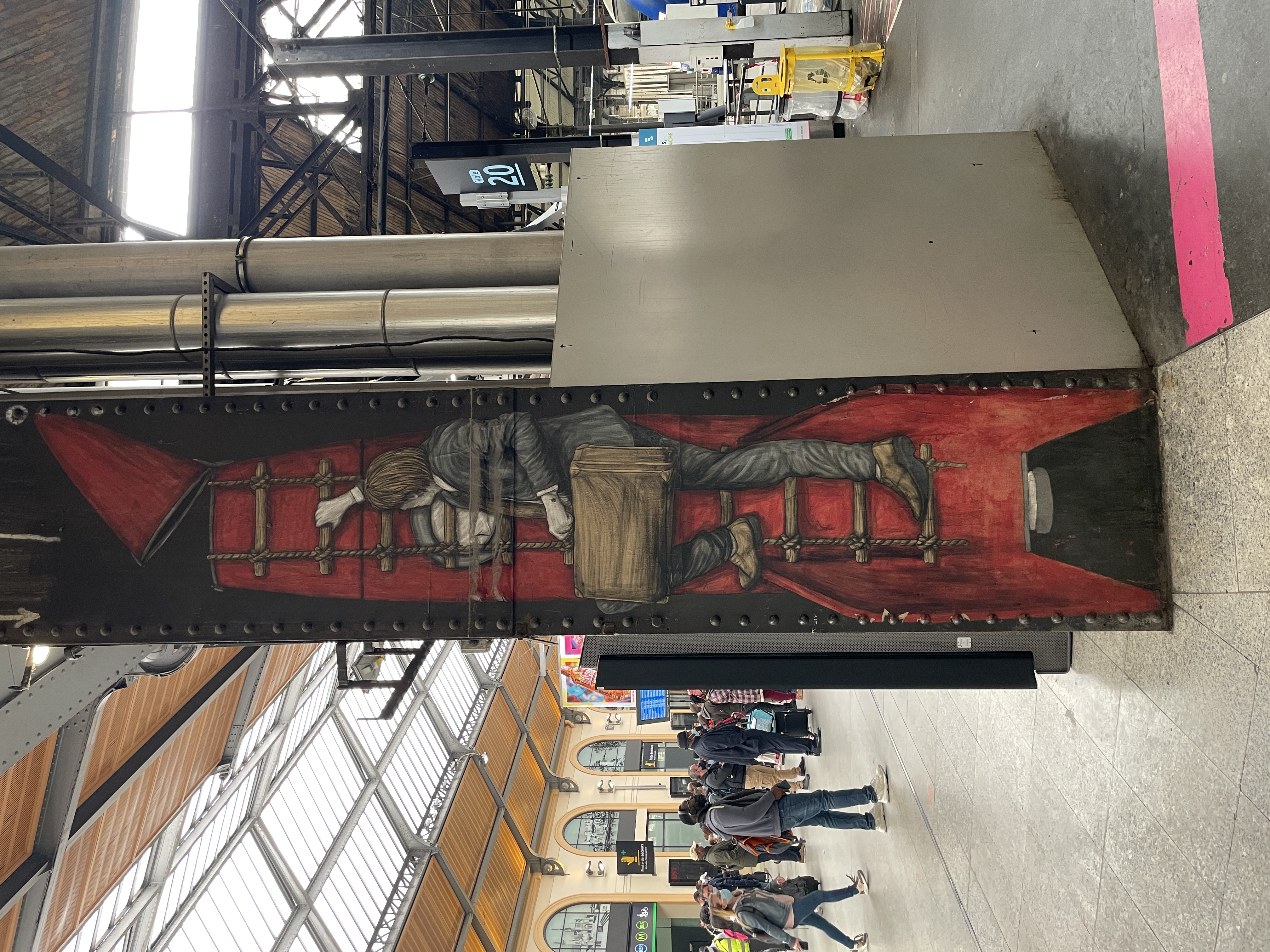

-1_TILE_578x578)